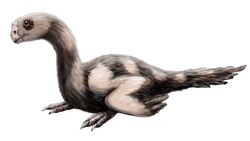Biology:Microvenator
| Microvenator | |
|---|---|

| |
| Skeletal restoration | |
| Scientific classification | |
| Domain: | Eukaryota |
| Kingdom: | Animalia |
| Phylum: | Chordata |
| Clade: | Dinosauria |
| Clade: | Saurischia |
| Clade: | Theropoda |
| Family: | †Caenagnathidae |
| Genus: | †Microvenator Ostrom, 1970 |
| Species: | †M. celer
|
| Binomial name | |
| †Microvenator celer Ostrom, 1970
| |
Microvenator (meaning "small hunter") is a genus of dinosaur from the Early Cretaceous Cloverly Formation in what is now south central Montana. Microvenator was an oviraptorosaurian theropod. The holotype fossil is an incomplete skeleton, most likely a juvenile with a length of 1.3 m (4.3 ft),[1] and consequently, the adult size remains uncertain.[2] Microvenator celer is primitive and may be the "sister taxon to all other oviraptorosaurs."[3][4]
Discovery
Barnum Brown collected the type specimen (AMNH 3041) in 1933 by a field party working for the American Museum of Natural History and he erroneously included Deinonychus teeth with the specimen. Because of this, Brown informally dubbed it "Megadontosaurus" ("big-toothed lizard"), Brown made illustrations of it, but never published the name, a fate shared with several other Cloverly Formation dinosaurs (Deinonychus, Sauropelta and Tenontosaurus). AMNH 3041 consists of a partial posterior skull, right dentary, 23 vertebrae, four ribs, the left coracoid, a partial left forelimb, a partial pelvis, and partial hindlimbs.[5] It was not until 1970 that John Ostrom described the type specimen as part of his work on the Cloverly Formation, naming it Microvenator celer meaning "swift small hunter" due to its long legs.[4] Ostrom originally theorized it was part of Othniel Marsh's Coeluridae due to features in the cervical vertebrae.[4] Ostrom also referred a single tooth from the Yale Peabody Museum collection, YPM 5366, to this new species that likely belongs to Deinonychus.[4] The illustrations that Brown had prepared were finally published in a detailed and exhaustive monograph by Mackovicky and Sues in 1998. They confirmed that Microvenator is an oviraptorosaurian, and that it is the earliest known member of this group from North America.[5]
A second species, "Microvenator chagyabi", has also been named for an indeterminate coelurosaurian theropod dinosaur, from the Early Cretaceous Lura Formation of Tibet. However, it is not formally named, and remains a nomen nudum.[6]
Paleoenvironment
Microvenator fossils are extremely rare, with only the type specimen described, likely due to lack of teeth and frail bones.[7] Microvenator coexisted with notable dinosaurs like Deinonychus, Sauropelta, and Acrocanthosaurus in the Himes Member of the Cloverly Formation.
See also
References
- ↑ Holtz, Thomas R. Jr. (2012). Dinosaurs: The Most Complete, Up-to-Date Encyclopedia for Dinosaur Lovers of All Ages. http://www.geol.umd.edu/~tholtz/dinoappendix/HoltzappendixWinter2011.pdf. "Winter 2011 Appendix"
- ↑ Paul, Gregory S. (2016). The Princeton Field Guide to Dinosaurs. Princeton University Press. pp. 176. ISBN 978-1-78684-190-2. OCLC 985402380. http://worldcat.org/oclc/985402380.
- ↑ Varricchio, D. J. 2001. Late Cretaceous oviraptorosaur (Theropoda) dinosaurs from Montana. pp. 42–57 in D. H. Tanke and K. Carpenter (eds.), Mesozoic Vertebrate Life. Indiana University Press, Indianapolis, Indiana.
- ↑ 4.0 4.1 4.2 4.3 Ostrom, John H. (1970) Stratigraphy and Paleontology of the Cloverly Formation (Lower Cretaceous) of the Bighorn Basin Area, Wyoming and Montana. Yale University Press, 2020, doi:10.2307/j.ctvxkn7tk.
- ↑ 5.0 5.1 Makovicky, Peter J.; Sues, Hans-Dieter (1998) (in en-US). Anatomy and phylogenetic relationships of the theropod dinosaur Microvenator celer from the Lower Cretaceous of Montana. American Museum novitates ; no. 3240. https://digitallibrary.amnh.org/handle/2246/3239.
- ↑ Zhao, X. (1985). [The Jurassic Reptilia]. [The Jurassic System of China. Stratigraphy of China, No. 11] 286–290.
- ↑ Carrano, Matthew T.; Oreska, Matthew P. J.; Lockwood, Rowan (2016-03-03). "Vertebrate paleontology of the Cloverly Formation (Lower Cretaceous), II: Paleoecology" (in en). Journal of Vertebrate Paleontology 36 (2): e1071265. doi:10.1080/02724634.2015.1071265. ISSN 0272-4634. Bibcode: 2016JVPal..36E1265C. http://www.tandfonline.com/doi/full/10.1080/02724634.2015.1071265.
Wikidata ☰ Q133881 entry
 |


